Caveat emptor: Driving in Ho Chi Minh City is quite, almost night & day, different from Hanoi or Hue. So, with allowance made for different driving styles (not unlike Californians versus Utahns), I will describe the motorbike and then later driving.
First, go to Virtual Doug's different posts on "Two wheeling in Vietnam." They do a good job at showing some driving thoughts.
Second, this is what a typical motorbike looks like.
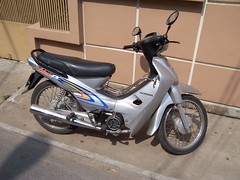 This particular bike is a Honda Wave Alpha. I venture to say it is the most common motorbike in Vietnam. There are numerous chinese knockoffs, including a "Panamacyan Wave Alpha" with the exact same paint job that I saw earlier today.
This particular bike is a Honda Wave Alpha. I venture to say it is the most common motorbike in Vietnam. There are numerous chinese knockoffs, including a "Panamacyan Wave Alpha" with the exact same paint job that I saw earlier today.The average motorbike in Vietnam runs at about 110cc to 125cc. There are new ones, like the Honda Dylan 150cc or the SYM Attilla 150cc that are the equivalent of the BMW 700 series for motorbikes. There are also smaller, 50cc and 100cc motorbikes, but most people have some version of the Honda Wave Alpha and run at 110cc or 125cc.
By the way, a brand new Honda Wave Alpha is currently selling in Saigon (more expensive than Hanoi) for $13,000,000 VND ( around $900 USD). The new SYM Attillas are going for more than $6000 USD. Also remember that the market has driven down prices here. A 125cc bike in America would cost a ton, since the old 50cc bikes are going for $2000 USD.
The dashboard of a motorbike looks like this:
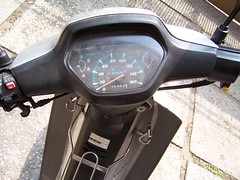 You can see that central to everything is the odometer, in kilometers/hr. This makes things interesting, because you always think you're going faster than you are. You feel the wind blowing through your hair and look down read "45" and you think "Wow, I'm really flying!" until you realize that 45 kmh is more like 27 mph.
You can see that central to everything is the odometer, in kilometers/hr. This makes things interesting, because you always think you're going faster than you are. You feel the wind blowing through your hair and look down read "45" and you think "Wow, I'm really flying!" until you realize that 45 kmh is more like 27 mph.It is connected directly to the front tire--you steer right, your wheel goes right, and vice versa. Also on the dashboard is the gas gauge to the right. Typically, a Honda Wave Alpha guzzles gas compared to newer models like the SYM Attilla, so I fill up every 2-3 days (more like two, because city driving in Saigon is very VERY stop and go and I drive all over the city for work and stuff). It takes about 20,000 VND to fill up every time. So, I put about $1.33 USD in my motorbike every 2 days (or 3 times a week) making price per gallon pretty comparable to the US, but actual money spent is less, because at $1.33 per fillup, I'm spending about $4 USD a week on gas, compared with $12/week in the USA in my gas-guzzling 1990 Toyota.
In addition to the gas gauge, to the left of the odometer is the gear indicator which shows whether you are in neutral, 1st, 2nd, 3rd, or 4th.
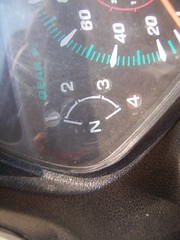 The new Honda Dylan 150s and SYM Attilla 150s are called "xe ga" because they are automatic, but most, maybe 90% of motorbikes, are manual. You start the bike in neutral, and cruise in 4th. When weaving through densly packed intersections, most use 2nd or 3rd. You change gears with a lever on your left side by your foot.
The new Honda Dylan 150s and SYM Attilla 150s are called "xe ga" because they are automatic, but most, maybe 90% of motorbikes, are manual. You start the bike in neutral, and cruise in 4th. When weaving through densly packed intersections, most use 2nd or 3rd. You change gears with a lever on your left side by your foot.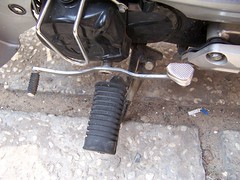 The big black knob is where you rest your foot. The smaller black knob is pressed down to shift from 1st to 2nd and so forth. The heel of your foot is used to press down on the flat silver knob at the other end of the shaft to downshift. This system is incredibly simple and easy to use, even for someone like me who cannot drive a stick back at home. The clutch is automatic, and if you let off the gas a little, you can usually hear it kick in easily.
The big black knob is where you rest your foot. The smaller black knob is pressed down to shift from 1st to 2nd and so forth. The heel of your foot is used to press down on the flat silver knob at the other end of the shaft to downshift. This system is incredibly simple and easy to use, even for someone like me who cannot drive a stick back at home. The clutch is automatic, and if you let off the gas a little, you can usually hear it kick in easily. On the left handle, you get maybe the most important piece of equipment on a motorbike (not the lights)--the horn.
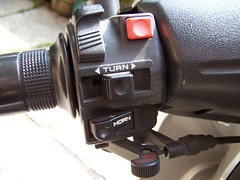 The horn is used to signal when you are coming up on someone fast, or to make other people aware of your presence. It's used far more common in Hanoi than in Saigon, but it is still heard ubiquitously, especially because the streets are usually a mix of motorbikes, rickshaws, bicycles, and insanely driven buses.
The horn is used to signal when you are coming up on someone fast, or to make other people aware of your presence. It's used far more common in Hanoi than in Saigon, but it is still heard ubiquitously, especially because the streets are usually a mix of motorbikes, rickshaws, bicycles, and insanely driven buses. 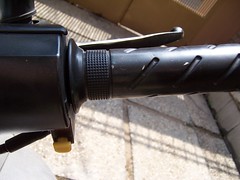
The right handle is the gas, a break, and the starter (the yellow knob). Gas is given like a motorcycle, by turning the handle towards you.
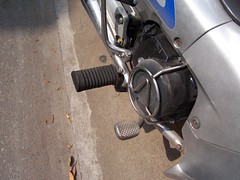
The second most important piece on a motorbike is the break. You can see it here as the flat silver lever in front of the black footpeg on the right side of the bike (opposite side from the gear shifter lever). Since traffic laws are in their infancy in Vietnam, and the roads are shared by everything from cows to buses, breaking is almost as ubiquitous as honking.
Also on the right side of the bike with the break is the foot crank.
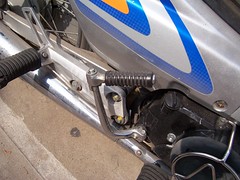
Sometimes the electronic starter fails (like it did for me this morning) and the footcrank is used to get it going. My morning was a freak morning, and my alpha actually started electronically after a bit, but on older bikes, the footcrank is used often. Also seen in this picture is a second footpedal.
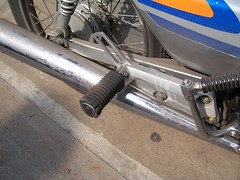
Each motorbike as a second set of footpedals (one on each side) for the second passenger on the bike to rest his/her feet. As you will find out later, two people on a motorbike is not only common, it is few. You cannot go longer than a day without seeing one motorbike carrying four people. The Vietnamese are ingenious people, and they've turned their ingenuity to their mode of travel very well.
On either side of the dashboard rest clips where you can hang your bags. Very handy after going to the grocery store.
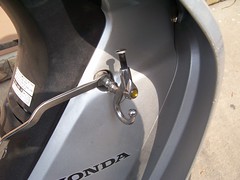
And finally there's the kickstand.
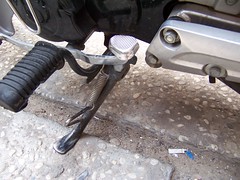 It looks similar to a regular bike kickstand, and allows the bike to rest at a slant like you see in the first picture. When people want to stand the bikes closer together, they will use a second, double kickstand, which acts as two training wheels on a bike do to stand the motorbike straight up.
It looks similar to a regular bike kickstand, and allows the bike to rest at a slant like you see in the first picture. When people want to stand the bikes closer together, they will use a second, double kickstand, which acts as two training wheels on a bike do to stand the motorbike straight up. Well, that is the general overview of a motorbike--perhaps one of the most fun and dangerous ways ever to travel. Hopefully soon I will describe the various ways a motorbike is used and traffic in Vietnam. Until then, here's a picture of an intersection I was at recently (taken while stopped at a red light).
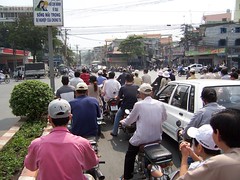








1 comment:
100 cc to 120cc bikes are also being driven here mostly in my country and they are really good in times of traffic. Though, there are lots of roads and highways they are not allowed to use, saving an hour or two out of traffic and burning less gasoline is still useful for the pocket. The only issue that I have about those motorbikes is the safety, I just hope that there would be ways in the future to make driving motorbikes more safe
Post a Comment